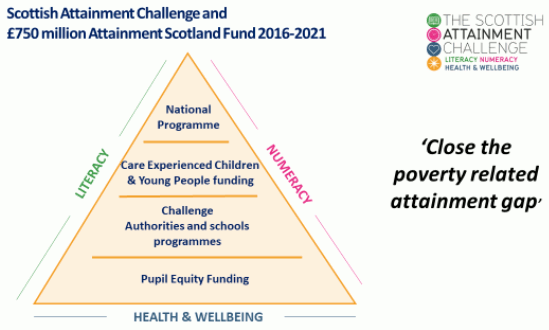Closing the poverty-related attainment gap: progress report 2016 to 2021
This report presents the evidence of progress towards achieving this defining mission over the period of the parliament 2016-2021. In doing so it also acknowledges the disruptive and detrimental impact of COVID-19.
Executive Summary
A vision for closing the poverty-related attainment gap
The shared vision for Scottish education is to deliver excellence and equity for all, with the defining mission of closing the poverty-related attainment gap, ensuring every child has the same opportunity to succeed.
This is a long-term commitment and has been supported by a system wide, collaborative endeavour between all partners within Scottish education to make Scotland the best place to grow and learn.
Report on progress
This report presents the evidence of progress towards achieving this defining mission over the period of the parliament 2016-2021. In doing so it also acknowledges the disruptive and detrimental impact of COVID-19.
While referencing the broader policy landscape, particular focus is made to the central role of the Scottish Attainment Challenge (SAC) and Attainment Scotland Fund (ASF) which was launched in February 2015.
The strategic aim of the SAC has been to ‘close the poverty-related attainment gap between children and young people from the least and most disadvantaged communities’.

The gap is closing, but it remains a long-term endeavour
The poverty-related attainment gap is closing, but this remains a complex and long-term endeavour. Equally, while there are positive indications of progress, there are also variations in the pace of that progress across the country. We know that the impact of COVID-19is likely to have placed further pressure on the gap.
However, over the 5-year time period a number of key elements have been put in place that provide strong foundations for on-going progress. Important strengths of the Scottish approach include: a systemic change in terms of culture, ethos and leadership; a strengthened awareness of the barriers facing children and young people adversely affected by socio-economic disadvantage; the significant role of local authorities in driving forward a strategic vision for equity at local level.
It is notable that the most recent evidence from the International Council of Education Advisers (ICEA) acknowledged the progress that is being made in Scottish education to close the attainment gap through the SAC and wider education policies:
“Scottish education exhibits many strengths. It values equity as well as excellence. It has an excellent standing internationally. It is investing effort and resources to narrow attainment gaps, working with and strengthening the teaching profession.”
There are a range of improved ways of working to deliver equity. These include:
- Enhanced learning and teaching and using data for improvement
- A sustained focus on health and wellbeing
- Collaborative working
- Working with families and communities
We also know that one of the key features of the SAC is the flexibility and opportunity it offers to schools and local authorities to select, develop and create interventions that best work for children and young people in the local context. Because of this, the SAC has seen a wide range of interventions and approaches develop in different settings.
As a result of this activity, there has been demonstrable progress on a number of long-term measures to close the poverty-related attainment gap. Headteachers are positive about the impact of SAC in their school, have a clear understanding of what is working, and are optimistic about improvements being embedded and continuing over the next five years. Where the level of progress has been more varied, this has often been a result of attainment of those from the most deprived areas increasing but not at the same rate as those in least deprived areas. The greater rate of progress that can be seen at primary school level aligns with the implementation of the SAC , which initially focused support towards improvement activity within primary schools.
A range of wider data sources provides additional insight into the longer term benefits for young people. An increasing proportion of young people from the most deprived areas are:
- in education, employment or training
- in a positive initial and follow up destination after school
- are attending Higher/Further Education
The gap between young people from the most and least deprived areas has narrowed across all these measures. At the same time the percentage of school leavers in a positive initial destination has consistently increased over the last ten years. However, the coronavirus pandemic has had an impact on destinations in the last year.
Reflecting on this progress to date provides an opportunity to consider further how we can accelerate and extend progress across all outcomes. This might include a focus on:
- A system-wide improvement strategy that promotes educational equity
- Maintaining a holistic and integrated approach
- Targeting to accelerate recovery and progress
- A renewed focus and a continued long term commitment
Going forward, the Scottish Government recognises that closing the poverty-related attainment gap will take time and remains committed to this task beyond this parliamentary term.
The evidence in this report, the Equity Audit and the views of partners, including the ICEA, and stakeholders, not least children and young people themselves, will be key to refining our approach going forward to accelerate recovery and progress and ensure all children and young people, regardless of their backgrounds, have the opportunity to succeed.
Contact
There is a problem
Thanks for your feedback